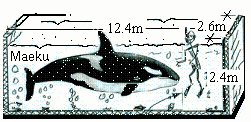| THERMO Spoken Here! ~ J. Pohl © | TOC NEXT ~ 243 |
Shipping Maeku
For the Orca to bremain calm the
water must be near freezing.

A killer whale captured off Japan is to be shipped air-freight to Miami in a large container the shippers call her "aquarium." During travel, Maeku will float in water, sedated and harnessed to his aquarium sides. During the 48 hour, pre-flight, flight, dry ice (solid carbon dioxide),will be dumped steadily into the aquarium to maintain its water at 5°C. Maeku is worth a fortune,we've been told repeatedly.
Some facts: Maeku is about 50,000 pounds, eats a lot and what he eats warms him up. To remain comfortable,about 106 calories per hour generated by his metabolism must be removed by carbon dioxide cooling. ed. The aircraft hold space,warmer than 5°C,is likely to add an average 300 kJ per hour for every square meter of water surface.
Calculate the least rate of dry ice to be added to the tank over the duration the trip.
♦ We take the water to be the system and we write the Energy Equation:

| (1) 1 |
Our system (called "open" by some) is a constant amount of water and carbon dioxide within it. The CO2 passes through as a "stream." Since 5°C is maintained,dU/dt of the system equals zero. With our space reference,(0XZ),attached to the floor of the aquarium,dKE/dt and dPE/dt are also equal to zero. Inspecting of the compression work rate we realize the system volume is constant hence dV/dt equals zero ~ the first term right of equality is zero. The entering ke and pe (lower case to be per-unit-mass) of the carbon dioxide is approximately equal that of the exiting flow. Sum these to zero. In the reference,the center of mass of the water does not move hence and there is no motor or pump hence the extrinsic work rate and shaft work rate are zero.

| (2) 2 |
The dry ice when added to the water will be very cold and at its lowest energy. As solid it will sink to the bottom of the tank. Being part of the system,the carbon dioxide will not experience heat. Rather,it will experience thermal equilibration with the warmer,adjacent water. The solid carbon dioxide will change phase from solid to gas - it will sublime and bubble up through the water to its surface. As it bubbles its temperature will increase to the 5°C temperature Maeku requires. Thus the energy of the exhausting carbon dioxide will be greater than that fed into the tank. A good technique for such calculations is to write the "lower energy," then beginning with the lower energy,construct the "higher energy" by adding energy amounts. See below:
The entering enthalpy (be patient with this equation) is:
| hin,CO2 = hin,CO2 | (3) 3 |
The carbon dioxide that leaves has higher energy. Its enthalpy equals its initial value plus the enthalpy of sublimation ("sub" ~ (hsg = hg - hs) plus the energy increase required to attain 5°C.
| hout,CO2 = hin,CO2 + hsg,CO2 + cp( 5°C - Tsub) | (4) 4 |
Subtracting these expressions,(3) - (4) we obtain the enthalpy difference we seek:
| hin,CO2 - hout,CO2 = - hsg,CO2 - cp( 5°C - Tsub) | (5) 5 |
Entering this property information of carbon dioxide into equation (2) yields:

| (6) 6 |
Data for carbon dioxide at one atmosphere are available.
| CARBON DIOXIDE at 101 kPa | |||||
| T(°C) | ρsol (kg/m3) | ρgas (kg/m3) | hsol(kJ/kg) | hgas(kJ/kg) | cp,vap(J/g°C) |
| -78.9 | 1565 | 2.51 | 70 | 643 | 0.85 |
| Carbon Dioxide,(CO2),sublimes at -78.9°C | |||||
Applying numbers to equation (6):

| (7) 7 |
Follow through with the numbers carefully (is this right?):

| (8) 8 |
There was no reason to algebraically manipulated the equation. Things were complicated enough, as is.
Most of all, the Orca needs to be calm (sedated).
Next, near freezing water is a must.
Shipping Maeku

A killer whale captured off Japan is to be shipped air-freight to Miami in a container. To travel, Maeku will float in water, sedated, and harnessed to the sides of his aquarium. During the 48 hour flight,dry ice (solid carbon dioxide), will be dumped steadily into the aquarium to maintain its water at 5°C.
Premise presently unwritted!